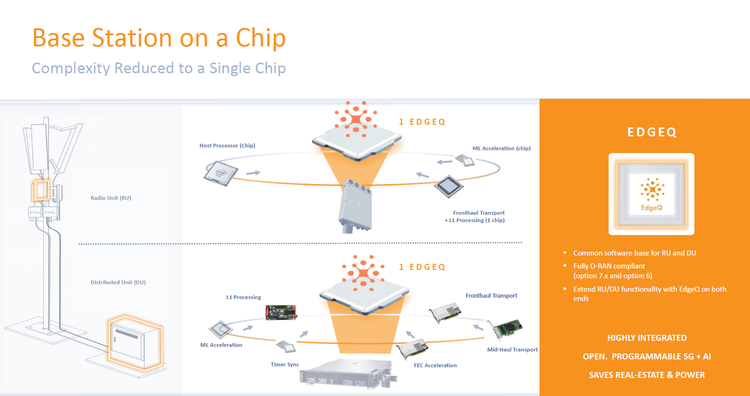EdgeQ Takes On Intel’s 5G Play With AI-Infused Modem Chip
EdgeQ claims its RISC-V-based 5G modem chip can replace the functions of multiple, discrete hardware components, including Intel Xeon processors and Intel FPGAs, in 5G base stations, lowering the costs and power of such deployments significantly.

A startup helmed by semiconductor veterans is taking on Intel and other chip-making giants with a new, AI-infused 5G modem chip that can replace multiple hardware components in a base station at a fraction of the cost and power.
EdgeQ — a Santa, Clara, Calif.-based startup that came out of stealth mode last fall with $51 million in funding from investors — revealed its synonymous “base-station-on-a-chip” on Tuesday, promising a 50 percent reduction in total cost of ownership for 5G base stations over competing solutions, which include hardware stacks that rely on Intel’s Xeon processors and FPGA chips. The startup also announced that former Qualcomm CEO and Executive Chairman Paul Jacobs and former Qualcomm CTO Matt Grob have joined the company’s advisory board.
[Related: Intel Unveils Next-Gen SmartNICs As Nvidia Plots DPU Takeover]
“EdgeQ’s solution, based on the open design of RISC-V processors, enables innovation deeper in the wireless technology stack,” Jacobs said in a statement. “This will allow both general performance improvements as well as the design of wireless systems that are tailored to specific use cases. I look forward to working with new entrants and pioneers, such as EdgeQ, to capitalize on wireless innovations and market forces that will bring to life the expected benefits of 5G and beyond.”
The EdgeQ chip is based on the open-source RISC-V CPU architecture, which has emerged as an alternative to x86, which dominates the PC and server markets, and Arm, which dominates smartphones and IoT devices. But the “secret sauce” of the EgdeQ chip is a combination of extended vector extensions and custom instructions written by the startup that allows the chip’s six RISC-V cores to perform a variety of 5G network and AI functions.
The benefit is that the EdgeQ chip is performing those functions from the same component instead of separate hardware, which means savings in power and in cost, according to Adil Kidwai, EdgeQ’s vice president and head of product management. And the chip is based on a design that can be scaled from radio units and distributed units in base stations to access points and IoT devices.
“The data transfer between 5G and AI is very fast,” said Kidwai, who previously worked on Intel’s Nervana AI processors and 5G modem chips. “And for the edge applications where you have very low latency, where data needs to be processed and [transferred] to a command center within a matter of milliseconds, we are perfectly suited for those applications.”
The EdgeQ chip is fully programmable in C and C++ coding languages, which Kidwai said makes it more accessible for customers to program and provide differentiation against competitors. For instance, a company could program three of the RISC-V cores to perform AI functions while the other three perform 5G functions.
“That is a pain point that we are solving,” Kidwai said. “We are letting the OEMs create differentiation by writing their own algorithms onto the physical layer, enabling new features for 5G.”
But while the EdgeQ chip can perform AI functions for edge computing applications, such as computer vision in a factory, the startup is pitching the new silicon as a modem chip first that can run AI workloads while also using AI to improve network capabilities.
Vinay Ravuri, EdgeQ’s CEO and founder, said he decided to focus on the 5G opportunity rather than the AI chip market, which is much more crowded right now, because “there is a much bigger opportunity for a startup to gain traction and get revenue on 5G.”
“From a hardware perspective, I wouldn’t say they’re that different. But 5G firmware, which is the algorithms themselves, are a lot harder to implement and a lot harder to make mature than AI is,” he said. “And for that reason, there’s like two or three companies doing 5G and then there are 200 or 300 companies doing AI chips.”
However, while Ravuri thinks he can claim EdgeQ as the world’s only “5G silicon” company, he will have to contend against semiconductor giants like Intel and his former employer, Qualcomm, as well as telecom infrastructure giants like Huawei and Ericsson in the 5G arms race.
But thanks to the unique architecture of the EdgeQ chip, Ravuri and his team think they have an opportunity to win over companies working on 5G network infrastructure, particularly because of how the chip can replace the functions of multiple, discrete hardware components, including Intel Xeon processors and Intel FPGAs, lowering the costs and power of such deployments significantly.
“These bigger players coming into it, I generally see it as a good thing, because it’s sort of validating where we are at, and we’re ahead of it,” Ravuri said.